|
Yokohama offers a wealth of different
transportation options. You can arrive by train, car, or airplane; once
arrived, you can travel around the city on foot or by train, bus, or taxi. For
sightseers there are additional options, including a number of
harbor cruises on the Marine Rouge and Marine Shuttle. The
same company also operates the Sea Bass
water taxi, which connects Aka-Renga Park and Yamashita Park.
We took a cruise on the Marine Rouge.
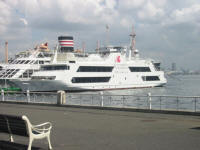 Here
the Marine Rouge is seen in front of the Marine Shuttle, as viewed
from the bayfront promenade in Yamashita Park. Here
the Marine Rouge is seen in front of the Marine Shuttle, as viewed
from the bayfront promenade in Yamashita Park.
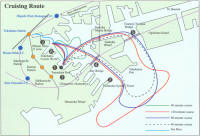 Although the Marine Rouge has a number of elegant
dining rooms and offers lunch and dinner cruises (90 and 120 minutes
respectively), as well as a 90-minute sunset cruise, we took the afternoon cruise,
which (depending on whether I believe the Japanese brochure or the English one)
was a 90-minute cruise leaving Yamashita Park at 1:30 p.m. or a 60-minute
one leaving at 2:30. The time stamps on my photos, however, suggest a 60-minute
duration, and the tickets seem to have been purchased at 2:00 (moreover, Barney
and I were checking out at FamilyMart at 1:23/1:24). The map at left
(click to enlarge) shows the routes taken by the Marine Rouge
cruises. Although the Marine Rouge has a number of elegant
dining rooms and offers lunch and dinner cruises (90 and 120 minutes
respectively), as well as a 90-minute sunset cruise, we took the afternoon cruise,
which (depending on whether I believe the Japanese brochure or the English one)
was a 90-minute cruise leaving Yamashita Park at 1:30 p.m. or a 60-minute
one leaving at 2:30. The time stamps on my photos, however, suggest a 60-minute
duration, and the tickets seem to have been purchased at 2:00 (moreover, Barney
and I were checking out at FamilyMart at 1:23/1:24). The map at left
(click to enlarge) shows the routes taken by the Marine Rouge
cruises.
I don’t recall that we even went
inside; it’s possible the dining rooms were closed. Instead, we stayed up on the
Sky Deck and observed the passing
scene, which included the following:
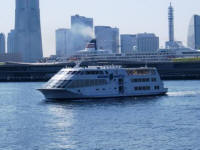 The
Marine Shuttle, with the Minato Mirai skyline in the background. The
Marine Shuttle, with the Minato Mirai skyline in the background.
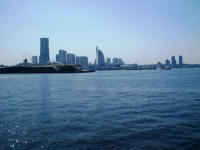 The
skyline at a greater distance. The two most striking buildings are the Yokohama
Landmark Tower (left), the tallest skyscraper in Japan, and the Intercontinental Hotel The Grand Yokohama
(the distinctively curved building in the center). The
skyline at a greater distance. The two most striking buildings are the Yokohama
Landmark Tower (left), the tallest skyscraper in Japan, and the Intercontinental Hotel The Grand Yokohama
(the distinctively curved building in the center).
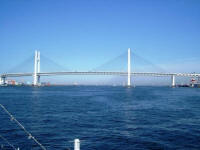 The
Yokohama Bay Bridge. This 860-meter-long bridge linking Honmoku Pier and
Daikoku Pier was opened in 1989 and is one of the largest suspension bridges in
the world. The Sky Walk
connected to the bridge at Daikoku Pier offers a panoramic view of Yokohama Port
as well as Mount Fuji and the Boso Peninsula. The
Yokohama Bay Bridge. This 860-meter-long bridge linking Honmoku Pier and
Daikoku Pier was opened in 1989 and is one of the largest suspension bridges in
the world. The Sky Walk
connected to the bridge at Daikoku Pier offers a panoramic view of Yokohama Port
as well as Mount Fuji and the Boso Peninsula.
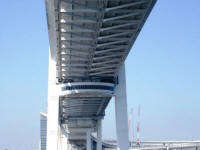 The
underside of the bridge, showing the Sky Lounge at the end of the Sky Walk. The
underside of the bridge, showing the Sky Lounge at the end of the Sky Walk.
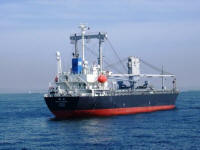 The
freighter Bright Pescadores, registered in Panama. The
freighter Bright Pescadores, registered in Panama.
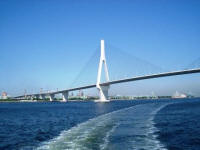 The
Tsurumi Tsubasa bridge. It was given its name because it spans the Tsurumi River
like the wings (“tsubasa”)
of a bird. The
Tsurumi Tsubasa bridge. It was given its name because it spans the Tsurumi River
like the wings (“tsubasa”)
of a bird.
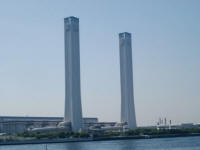 Part
of the Tokyo Electric Power Company’s
Yokohama
Thermal Power Station, a CCGT (combined-cycle gas turbine) plant, which
operates on
LNG
(liquefied natural gas). We were told (obviously erroneously) that the towers
were garbage incinerator chimneys. Part
of the Tokyo Electric Power Company’s
Yokohama
Thermal Power Station, a CCGT (combined-cycle gas turbine) plant, which
operates on
LNG
(liquefied natural gas). We were told (obviously erroneously) that the towers
were garbage incinerator chimneys.
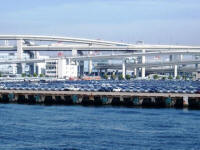 Automobiles
for export, awaiting shipment to the rest of the world (Yokohama Bay Bridge
approaches in the background). Automobiles
for export, awaiting shipment to the rest of the world (Yokohama Bay Bridge
approaches in the background).
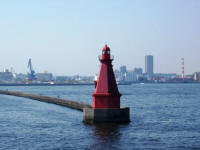 A
lighthouse sort of thing in the harbor. A
lighthouse sort of thing in the harbor.
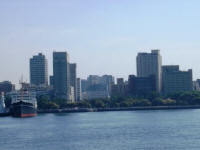 Yamashita
Park in the foreground; in the background are the many hotels lining it along
Yamashitakoen-dori (Yamashita Park Street). The Novotel (where we stayed) is the
light-brown one just to the right of center. Yamashita
Park in the foreground; in the background are the many hotels lining it along
Yamashitakoen-dori (Yamashita Park Street). The Novotel (where we stayed) is the
light-brown one just to the right of center.
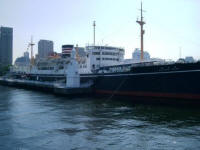 The
Hikawa Maru, a classic luxury liner now
permanently moored (next to the Marine Rouge dock) as a tourist
attraction. The
Hikawa Maru, a classic luxury liner now
permanently moored (next to the Marine Rouge dock) as a tourist
attraction.
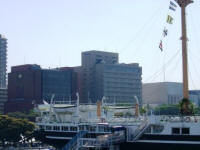 The
Yokohama Novotel (center) behind the Hikawa Maru. The
Yokohama Novotel (center) behind the Hikawa Maru.
| 